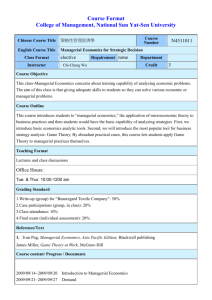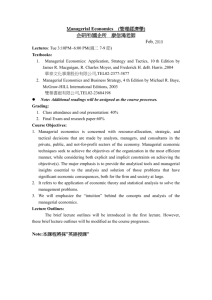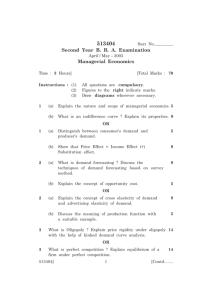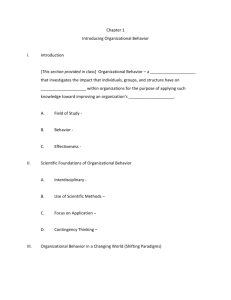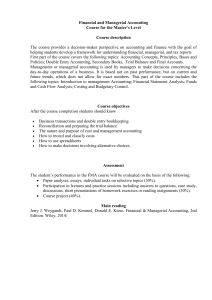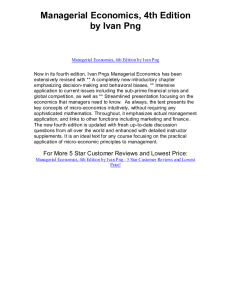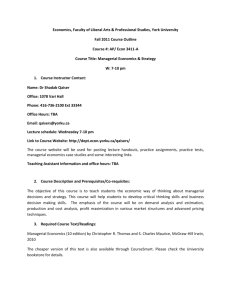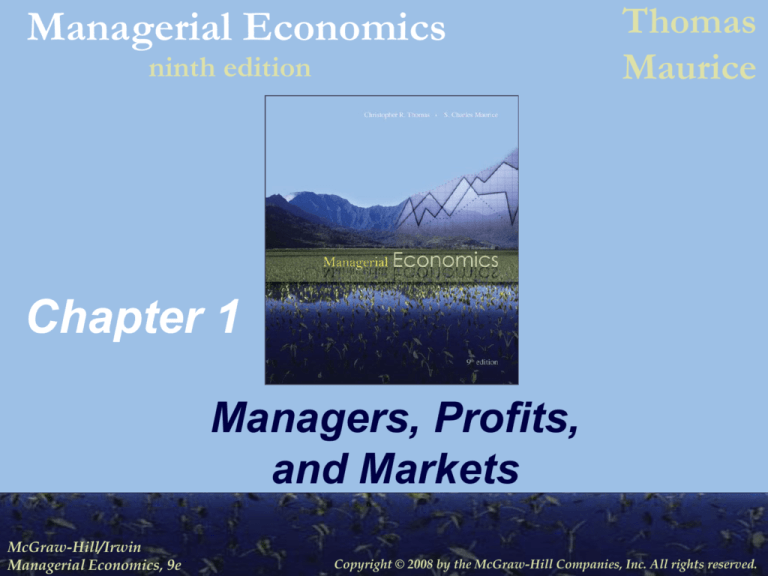
Managerial Economics
ninth edition
Thomas
Maurice
Chapter 1
Managers, Profits,
and Markets
McGraw-Hill/Irwin
McGraw-Hill/Irwin
Managerial Economics, 9e
Managerial Economics, 9e
Copyright © 2008 by the McGraw-Hill Companies, Inc. All rights reserved.
Managerial Economics
Managerial Economics & Theory
• Managerial economics applies
microeconomic theory to business
problems
• How to use economic analysis to make
decisions to achieve firm’s goal of
profit maximization
• Microeconomics
• Study of behavior of individual
economic agents
1-2
Managerial Economics
Economic Cost of Resources
• Opportunity cost of using any
resource is:
• What firm owners must give up to use
the resource
• Market-supplied resources
• Owned by others & hired, rented, or
leased
• Owner-supplied resources
• Owned & used by the firm
1-3
Managerial Economics
Total Economic Cost
• Total Economic Cost
• Sum of opportunity costs of both
market-supplied resources & ownersupplied resources
• Explicit Costs
• Monetary payments to owners of
market-supplied resources
• Implicit Costs
• Nonmonetary opportunity costs of
using owner-supplied resources
1-4
Managerial Economics
Economic Cost of Using
Resources (Figure 1.1)
E
x
p
lic
itC
o
s
t
s
o
f
M
a
r
k
e
t
S
u
p
p
lie
d
R
e
s
o
u
r
c
e
s
T
h
e
m
o
n
e
ta
r
y
p
a
y
m
e
n
ts
to
r
e
s
o
u
r
c
e
o
w
n
e
r
s
+
Im
p
lic
itC
o
s
t
s
o
f
O
w
n
e
r
S
u
p
p
lie
d
R
e
s
o
u
r
c
e
s
T
h
e
r
e
tu
r
n
s
fo
r
g
o
n
e
b
y
n
o
tta
k
in
g
th
e
o
w
n
e
r
s
’r
e
s
o
u
r
c
e
s
to
m
a
r
k
e
t
=
1-5
T
o
t
a
lE
c
o
n
o
m
ic
C
o
s
t
T
h
e
to
ta
lo
p
p
o
r
tu
n
ity
c
o
s
ts
o
f
b
o
th
k
in
d
s
o
fr
e
s
o
u
r
c
e
s
Managerial Economics
Types of Implicit Costs
• Opportunity cost of cash provided
by owners
• Equity capital
• Opportunity cost of using land or
capital owned by the firm
• Opportunity cost of owner’s time
spent managing or working for the
firm
1-6
Managerial Economics
Economic Profit versus
Accounting Profit
• Economic profit = Total revenue – Total economic cost
= Total revenue – Explicit costs – Implicit costs
• Accounting profit = Total revenue – Explicit costs
• Accounting profitdoes not subtract
implicit costs from total revenue
• Firm owners must cover all costs of all
resources used by the firm
• Objective is to maximize economic profit
1-7
Managerial Economics
Maximizing the Value of a Firm
• Value of a firm
• Price for which it can be sold
• Equal to net present value of expected
future profit
• Risk premium
• Accounts for risk of not knowing
future profits
• The larger the rise, the higher the
risk premium, & the lower the firm’s
value
1-8
Managerial Economics
Maximizing the Value of a Firm
• Maximize firm’s value by maximizing
profit in each time period
• Cost & revenue conditions must be
independent across time periods
• Value of a firm =
1
(1 r )
1-9
2
(1 r )
2
...
T
T
(1 r )
T
t 1
t
(1 r )
t
Managerial Economics
Separation of Ownership &
Control
• Principal-agent problem
• Conflict that arises when goals of
management (agent) do not match
goals of owner (principal)
• Moral Hazard
• When either party to an agreement
has incentive not to abide by all its
provisions & one party cannot cost
effectively monitor the agreement
1-10
Managerial Economics
Corporate Control Mechanisms
• Require managers to hold
stipulated amount of firm’s equity
• Increase percentage of outsiders
serving on board of directors
• Finance corporate investments
with debt instead of equity
1-11
Managerial Economics
Price-Takers vs. Price-Setters
• Price-taking firm
• Cannot set price of its product
• Price is determined strictly by market
forces of demand & supply
• Price-setting firm
• Can set price of its product
• Has a degree of market power, which
is ability to raise price without losing
all sales
1-12
Managerial Economics
What is a Market?
• A market is any arrangement
through which buyers & sellers
exchange goods & services
• Markets reduce transaction costs
• Costs of making a transaction other
than the price of the good or service
1-13
Managerial Economics
Market Structures
• Market characteristics that determine
the economic environment in which
a firm operates
• Number & size of firms in market
• Degree of product differentiation
• Likelihood of new firms entering market
1-14
Managerial Economics
Perfect Competition
• Large number of relatively small
firms
• Undifferentiated product
• No barriers to entry
1-15
Managerial Economics
Monopoly
• Single firm
• Produces product with no close
substitutes
• Protected by a barrier to entry
1-16
Managerial Economics
Monopolistic Competition
• Large number of relatively small
firms
• Differentiated products
• No barriers to entry
1-17
Managerial Economics
Oligopoly
• Few firms produce all or most of
market output
• Profits are interdependent
• Actions by any one firm will affect
sales & profits of the other firms
1-18
Managerial Economics
Globalization of Markets
• Economic integration of markets
located in nations around the world
• Provides opportunity to sell more
goods & services to foreign buyers
• Presents threat of increased
competition from foreign producers
1-19

